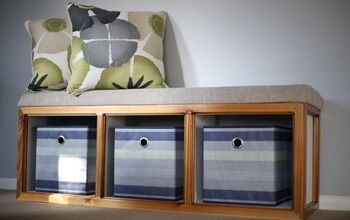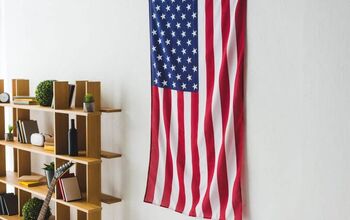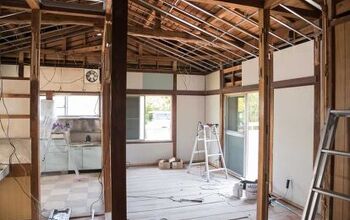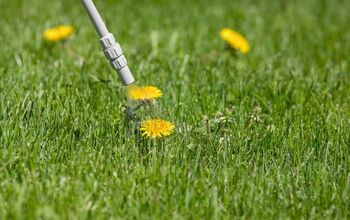How To Mount A Headboard To A Wall (Quickly & Easily!)

Headboards are a quick and easy way to add sophistication and style to your bedroom without breaking the bank. While headboards were originally attached to bed frames, these were known to loosen with time and use. This is in addition to loud banging from the headboard hitting the wall.
The “floating” headboard, or hanger headboard, has exploded in popularity in recent years due to its versatility. The floating headboard is attached to the wall at the head of the bed rather than the bed frame. This lends the headboard a floating effect as it makes a complete unit with the bed. Mounting to the wall results in a more stable headboard that will work with almost any sleeping arrangement.
To mount a headboard to the wall, you’ll need to first determine your desired placement of the bed. Then, measure the back of your headboard for the right hardware (usually heavy-duty picture frame mounts or mirror mounts). Next, use a stud finder and then fasten the mounting hangers to the studs in the wall. Finally, hang your headboard by lifting it above the mounting hangers and slide it into the brackets.
Do You Need Handyman Services?
Get free, zero-commitment quotes from pro contractors near you.

How Does a Wall Mounted Headboard Work?
A wall-mounted headboard works by connecting directly to the wall. Instead of attaching to the bed frame, the headboard appears to “hang” or “float” by means of interlocking hardware such as flush mount brackets or Z-clips. These brackets are screwed into the back of the headboard and stay out of sight.
Even weight distribution is crucial in securing the headboard to the wall. Once the headboard is safely attached, push your bed against the wall to complete the unit. Unlike a traditional headboard that has to match up to the frame, a wall-mounted headboard can be any size or material.
Some people choose a wall-mounted headboard strictly for aesthetic reasons. Floating headboards are polished and modern. Often they are the focal point of any bedroom. But it’s not just for looks– wall-mounted headboards are safer, too.
Headboards that are mounted to the wall offer additional stability and back support. They keep pillows from falling behind the bed while some even have built-in storage shelves for all your bedside necessities. By attaching the headboard to the wall, the headboard is less likely to bruise the wall or weaken the bed frame over time.
Tools You Will Need
Mounting your headboard to the wall is an easy DIY task that can be completed in just a few hours. You will need:
- Drill or screwdriver and Allen wrench
- Tape measure
- Stud finder
- Painter’s tape
- Pencil
- Level (optional)
- Interlocking flush mount brackets or the hardware that came with your headboard
Hardware Alternatives
Interlocking flush mount brackets can be found at your local hardware store and are easy to install. Since they are multipurpose hangers designed to keep objects flush with the wall, they are ideal for headboards, picture frames, mirrors, and other heavy-duty items.
Interlocking Z-clips is another excellent option. Much like flush mount brackets, Z-clips work with gravity to ensure that your headboard is tightly interlocked with the wall hardware.
If you are unable to locate studs in the wall, you may need to use toggle bolts, drywall anchors, or even employ the use of a French cleat. A French cleat is molding with a 30 – 45 degree slope used to hang heavy objects. The cleat is fastened to the wall, with the angle sloping up and out from the wall. This positioning will allow the corresponding mold to slide down and lock into the cleat.
Mounting Your Headboard to the Wall with Flush Mount Brackets
Step One: Determine Where You Want Your Headboard on the Wall
For a visual aid, draw reference lines on the wall with your pencil. Using your tape measure, locate a centerline (vertically) on both the back of the headboard and the corresponding wall area. Mark with painter’s tape and use as a reference point when measuring for hardware later.
Typically, the bottom edge of the headboard should extend a few inches below the top of the mattress for the desired “floating” effect.
Step Two: Measure for the Mounting Hardware
Every headboard varies, but you will need to examine the back of your headboard for solid wood backing. This is for the mounting brackets that you will attach to the back of your headboard. Lay your headboard down, backside facing up, but don’t install any hardware just yet.
Make sure to lay everything out before drilling any holes. Interlocking flush mount brackets are only effective when flush with other mounting hardware and the wall.
Step Three: Mount the Hangers
Run the stud finder over the desired location for the headboard. You will feel a pull when the magnet detects any nails in the drywall. Then, fasten the mounting hangers to the studs in the wall.
The mounting hanger on the wall should be angled upwards and out to catch the headboard bracket (angled down) as you slide it into position. This step is essential because it serves as the foundation of your headboard mount.
Generally, any object over 25 pounds should be attached to a stud or supporting structure in the wall. If unable to connect to any studs, the confidence of the headboard is compromised. See alternative considerations below.
Step Four: Install the Mounting Brackets
Match the mounting hangers in the wall to the solid wood backing on your headboard. Measure the space between each hanger in the wall and transfer it to the back of your headboard, making sure the measurements fit on the solid wood backing.
Mark with pencil or painter’s tape. Set headboard aside, backside facing up. Then, install the mounting brackets by attaching the corresponding brackets to the back of your headboard, making sure they align with the wall mounts.
For interlocking flush mount brackets, it’s imperative that the hardware placement line up, with the headboard fastener sliding down into the upper-facing wall mount.
Step Five: Hang Your Headboard
Once everything is secure, lift your headboard above the mounting hangers on the wall so that you are able to slide the headboard down the wall and into the proper brackets. You may need additional hands for this step.
Choosing a Headboard
There are many considerations when choosing a headboard. While each type of headboard can be aesthetically pleasing, it is important to find one that fits your particular needs.
Headboards have since evolved from the original wooden prototype. Now there are all kinds of headboards, including fabric, leather, upholstered, mirrored, wicker, tufted, brass, and wingback, as well as headboards with built-in bookcases and storage. Consider utility as well as aesthetics when shopping for your headboard.
Tufted or fabric headboards offer comfortable stability for young children and are perfect for adults that prefer to read or watch TV in bed. Iron and brass headboards are durable and easy to maintain, while wood remains a classic favorite.
Typical Headboard Sizes
| Bed size | Mattress dimensions | Headboard Width |
| Twin | 38 x 74 | 41 inches |
| Full | 54 x 75 | 56 inches |
| Queen | 60 x 80 | 62 inches |
| King | 76 x 80 | 80 inches |
| California King | 72 x 84 | 74 inches |
Additional Considerations
If creating new holes in your wall is not an option, your best alternative may be to mount your headboard to your bed frame. Many contemporary headboards are compatible with a basic metal frame. Another alternative is a freestanding headboard, which relies on remaining wedged between the wall and the bed frame.
Before making any holes, lay everything out first. The location of the studs in the wall will determine your best course of action.
Do You Need Handyman Services?
Get free, zero-commitment quotes from pro contractors near you.

Related Questions
Do I need a bed frame to mount a headboard to the wall?
While headboards used to be heavily reliant on bed frames, mounting your headboard to the wall is a much safer option. If you’ve still got your mattress or box spring on the floor, don’t be discouraged; your headboard will be just fine mounted to the wall without a frame.
What size should a headboard be?
Standard headboard sizes are 0-3 inches wider than the bed. For a modern look, try extending the headboard on both sides to encompass the nightstands. Standard headboards range from 14 inches to 29 inches tall when measured from the top of the mattress. There are no rules here, other than the general guideline that the height of the headboard should not be greater than the size of the bed. Some new contemporary headboards reach down to the floor.
Can you attach a headboard to the wall without screws?
A headboard can weigh anywhere from 50 to 200 pounds, depending on the materials. Since traditional headboard material includes heavy-duty elements such as wood, iron, and metal, it is not recommended that you use anything other than screws when mounting your headboard to the wall. If you are feeling especially creative, create your own DIY headboard from lighter materials such as cork, cloth, wicker, or foam. Attach to the wall using Command Adhesive Strips or Velcro. Command Adhesive Strips can hold up to 16 pounds and don’t leave a sticky mess on the wall. If you suspect your headboard might be too heavy, don’t risk it.
Related Guides

We are a team of passionate homeowners, home improvement pros, and DIY enthusiasts who enjoy sharing home improvement, housekeeping, decorating, and more with other homeowners! Whether you're looking for a step-by-step guide on fixing an appliance or the cost of installing a fence, we've here to help.
More by Upgraded Home Team














![How To Turn On A Gas Fireplace With A Wall Switch [Quickly & Easily]](https://cdn-fastly.upgradedhome.com/media/2023/07/31/9076525/how-to-turn-on-a-gas-fireplace-with-a-wall-switch-quickly-easily.jpg?size=350x220)












